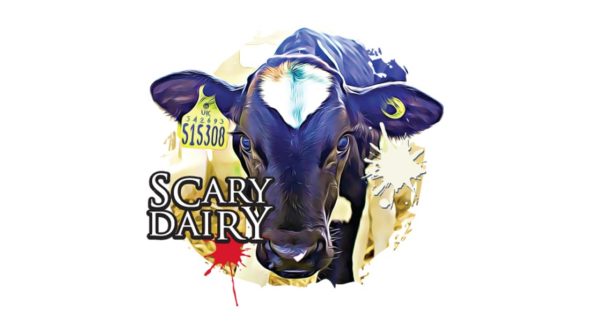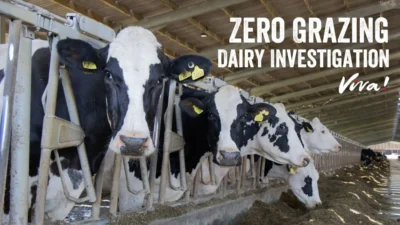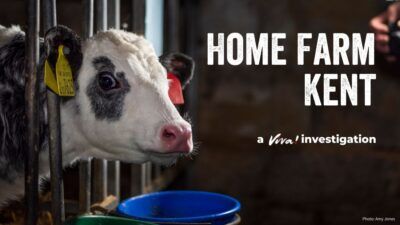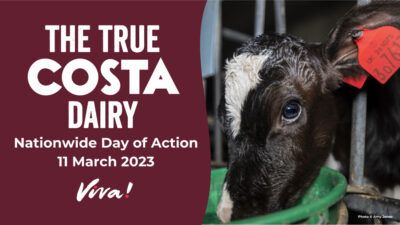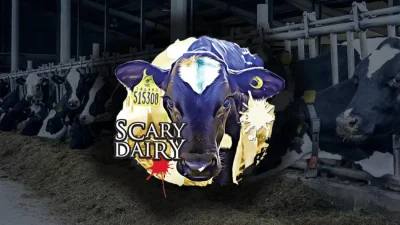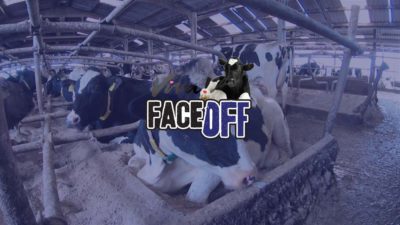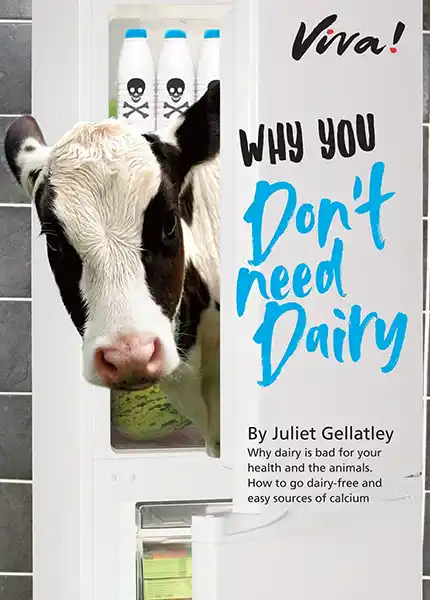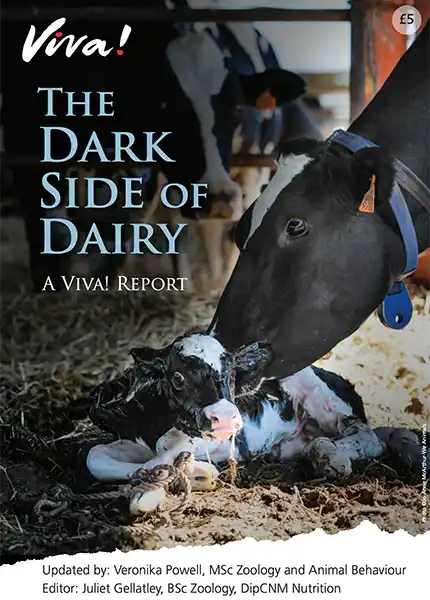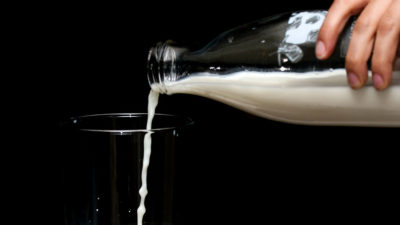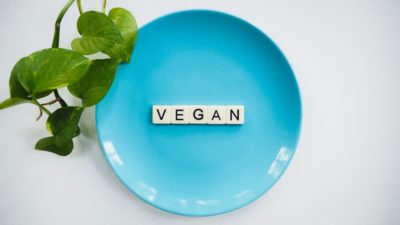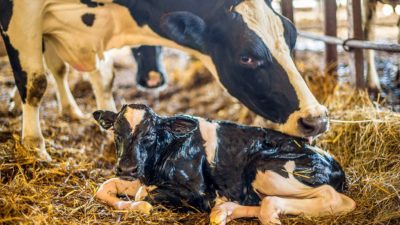How Dairy Cows Are Farmed and Killed

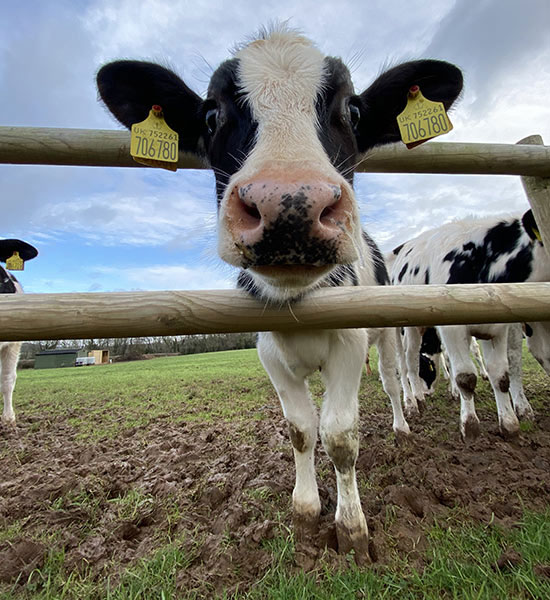
- Cows recognise different people and will pretend that they haven’t been fed in order to get second helpings!3Barkham P. 2017. Cows are loving, intelligent and kind – so should we still eat them? The Guardian, 30 October. Available at https://www.theguardian.com/environment/2017/oct/30/secret-life-of-cows-loving-intelligent-kind-eat-them [Accessed 25 March 2020].
- Cows have been known to play hide-and-seek, although they’re rather too big to be very good at the game1Barkham P. 2017. Cows are loving, intelligent and kind – so should we still eat them? The Guardian, 30 October. Available at https://www.theguardian.com/environment/2017/oct/30/secret-life-of-cows-loving-intelligent-kind-eat-them [Accessed 25 March 2020].
- Cows like to problem-solve and may get excited when they find solutions1Barkham P. 2017. Cows are loving, intelligent and kind – so should we still eat them? The Guardian, 30 October. Available at https://www.theguardian.com/environment/2017/oct/30/secret-life-of-cows-loving-intelligent-kind-eat-them [Accessed 25 March 2020].
- Cows are emotionally complex, have strong family bonds and grieve for calves they lose1Barkham P. 2017. Cows are loving, intelligent and kind – so should we still eat them? The Guardian, 30 October. Available at https://www.theguardian.com/environment/2017/oct/30/secret-life-of-cows-loving-intelligent-kind-eat-them [Accessed 25 March 2020].
- Cows make different noises to address different cows in the herd, just like people use different names for different individuals4Press Association. 2014. Cows communicate using individual sounds like human names. The Telegraph, 16 December. Available at https://www.telegraph.co.uk/news/newstopics/howaboutthat/11297269/Cows-communicate-using-individual-sounds-like-human-names.html [Accessed 25 March 2020].
- Cows can self-medicate, choosing to eat certain plants when they’re unwell; similar to people eating more fruit or hot soup when feeling sick!1Barkham P. 2017. Cows are loving, intelligent and kind – so should we still eat them? The Guardian, 30 October. Available at https://www.theguardian.com/environment/2017/oct/30/secret-life-of-cows-loving-intelligent-kind-eat-them [Accessed 25 March 2020].
The Maternal Instinct of Cows
Cows are highly social animals with a strict hierarchy. Within herds, the social structure is based on matriarchal families; mother cows and their female offspring remain grooming and grazing partners for life and typically have very strong bonds with each other.1 Sowell BF, Mosley JC and Bowman JGP. 1991. Social behavior of grazing beef cattle: implications for management. The American Society of Animal Science 77, 1-6. Cows also form lifelong friendships with other cows to form a herd and calves befriend other calves for the rest of their lives.2 Young R. 2003. The Secret Lives of Cows. Faber & Faber: London. Herds like stability; any disruption to the group, such as the addition of a new member, can be very stressful.1 Sowell BF, Mosley JC and Bowman JGP. 1991. Social behavior of grazing beef cattle: implications for management. The American Society of Animal Science 77, 1-6.
 Just like humans, cows are extremely protective and caring of their offspring. They give birth in private and hide the calf in long grass out of sight for about a week before introducing the newborn to the rest of the herd.1Sowell BF, Mosley JC and Bowman JGP. 1991. Social behavior of grazing beef cattle: implications for management. The American Society of Animal Science 77, 1-6. The herd approves the new member, who then joins them. Female calves suckle from their mother for nine months and then stay together for the rest of their lives. Male calves suckle for about a year and then leave to join a bachelor herd.
Just like humans, cows are extremely protective and caring of their offspring. They give birth in private and hide the calf in long grass out of sight for about a week before introducing the newborn to the rest of the herd.1Sowell BF, Mosley JC and Bowman JGP. 1991. Social behavior of grazing beef cattle: implications for management. The American Society of Animal Science 77, 1-6. The herd approves the new member, who then joins them. Female calves suckle from their mother for nine months and then stay together for the rest of their lives. Male calves suckle for about a year and then leave to join a bachelor herd.
While cows are sometimes portrayed as lacking intelligence, studies have shown that cows enjoy problem-solving, recognise individual humans, play games and have a variety of vocal calls to communicate with one another.3Kettlewell J. 2005. Farm animals need emotional TLC. The BBC, 18 March. Available at http://news.bbc.co.uk/1/hi/sci/tech/4360947.stm [Accessed 25 March 2020].4Press Association. 2014. Cows communicate using individual sounds like human names. The Telegraph, 16 December. Available at https://www.telegraph.co.uk/news/newstopics/howaboutthat/11297269/Cows-communicate-using-individual-sounds-like-human-names.html [Accessed 25 March 2020].5Barkham P. 2017. Cows are loving, intelligent and kind – so should we still eat them? The Guardian, 30 October. Available at https://www.theguardian.com/environment/2017/oct/30/secret-life-of-cows-loving-intelligent-kind-eat-them [Accessed 25 March 2020]. Cows have different personalities, hold grudges with one another, bicker, bond and form friendships that can last a literal lifetime.6University of Groningen. 2012. Dairy cows have individual temperaments. ScienceDaily, 23 March. Available at https://www.sciencedaily.com/releases/2012/03/120323134531.htm [Accessed 25 March 2020].
Cattle can also feel depression and anxiety. For example, calves kept in isolation hutches – a standard practice in the dairy industry – show clear signs of depression, just like solitary confinement affects humans negatively.7Gaillard C, Meagher RK, von Keyserlingk MAG et al. 2014. Social housing improves dairy calves’ performance in two cognitive tests. PLoS One. 9 (2) e90205. Available at https://doi.org/10.1371/journal.pone.0090205 [Accessed 25 March 2020]. There are clear similarities between cows and other animals, such as dogs or even ourselves, as highly social animals who depend upon one another for our mental wellbeing.
Unfortunately, despite the emotional complexity and intelligence evident in dairy cows, the way they are treated in modern UK farming shows a complete disregard for their wellbeing and their sentience.
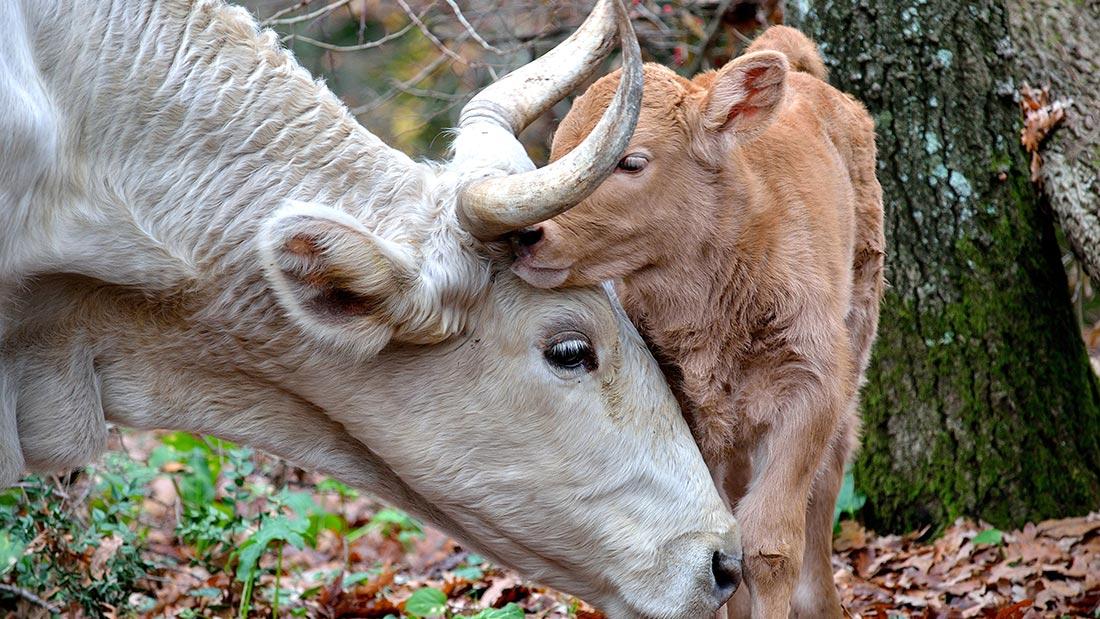
Cattle are highly intelligent, sentient mammals who have evolved complex social behaviours over thousands of years. Their natural lives are very different to those they are forced to endure on dairy farms.
Where do cows descend from?
Cattle are members of the Bovidae family, which includes antelope, goats, sheep, bison and buffalo. Modern domestic cattle (Bos taurus) descend from the much larger auroch (Bos taurus primigenius) which once ranged throughout Britain, Africa, the Middle East, India and Central Asia. Cows are believed to have been been domesticated some 10,000 years ago and selective breeding over the millennia has caused dramatic physical changes.1Bollongino R, Burger J, Powell A et al. 2012. Modern taurine cattle descended from small number of near-eastern founders. Molecular Biology and Evolution. 29 (9) 2,101-2,104.
Semi-wild cattle
Populations of semi-wild cattle still survive in several countries, including the white cattle of Chillingham Park in Northumberland, who have roamed free for at least 800 years. Studies of this herd and other semi-wild herds have provided insight into natural cattle behaviour.
Semi-wild cattle form small groups, averaging 15-20 animals with a strict social hierarchy. The structure is matriarchal, and offspring inherit the mother’s status in the herd. It is common for calves to establish lifelong friendships at a young age, and mutual grooming reinforces social bonds between cows.
Natural Diet
Contrary to the popular belief that cows just eat grass, they like a mixed diet. Just as humans have different preferences for different foods depending on the time of day, cattle show a preference for clover in the morning and grass in the evening, with more of an inclination towards clover than grass in general.2Rutter SM, Orr RJ, Yarrow NH et al. 2004. Dietary preference of dairy cows grazing ryegrass and white clover. Journal of Dairy Science. 87 (5) 1,317-1,324. May. Available at https://www.sciencedirect.com/science/article/pii/S0022030204732816 [Accessed 25 March 2020].
Life Expectancy of Cattle
Cattle have a life expectancy of approximately 20 years; some have even been known to live into their 30s at sanctuaries.
Predators
Depending on the location, cougars, lions, wolves and bears have been known to hunt cattle.
Semi-wild Cattle and Modern Cattle
Much of the behaviour found in semi-wild cattle can still be found in domesticated cattle. Despite having strong maternal instincts and a clear desire to bond with a stable herd, in modern dairy farming, calves are removed from their mothers shortly after birth. Cows have been known to grieve and fall into deep depression as a result, much like the loss a human mother would feel if her baby was forcibly removed.3University of Veterinary Medicine. 2015. Early separation of cow and calf has long-term effects on social behavior. ScienceDaily. 28 April. Available at https://www.sciencedaily.com/releases/2015/04/150428081801.htm [Accessed 25 March 2020]. Cows’ strict social hierarchies cannot be maintained in the dairy industry, where herds vary significantly in size and there are frequent additions and removals.
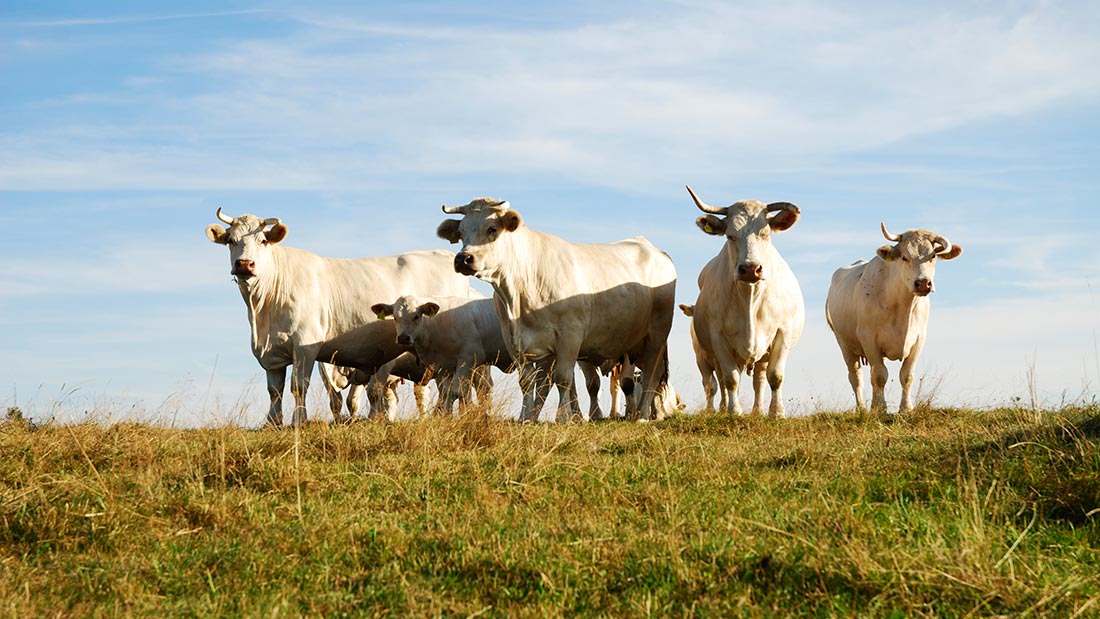
One of the public’s biggest misconceptions about dairy production is the way in which cows produce milk. Many are still unaware that in order to produce milk, a cow first needs to be pregnant, just like humans, and must give birth every year in order to meet the demands of modern, high-yield dairy farming.
How many dairy cows are there in the UK?
The dairy industry has been in long-term decline and this is expected to continue.1AHDB. 2023. GB milk production forecasted to decline in 2022/23. Available at https://ahdb.org.uk/news/gb-milk-production-forecasted-to-decline-in-2022-23 [Accessed 5 October 2023]. However, the number of cows farmed for milk in the UK is still enormous.
Modern dairy farms divide cows into different groups depending on their milk production status. The milking herd only includes cows that are currently lactating and there are around 1.8 million of them in the UK.2 Department for Environment, Food and Rural Affairs. 2023. Agriculture in the UK, 2022. Available at https://www.gov.uk/government/statistics/agriculture-in-the-united-kingdom-2022/chapter-8-livestock [Accessed 5 October 2023]. Dry cows are so-called because they are not milked during a brief ‘resting period’ before giving birth and young cows (also not milked) that have yet to give birth to their first calf are called heifers. When they are old enough to give birth they will take the place of older, worn out cows in the milking herd and thus are sometimes called ‘replacers’. Because there are so many of them, rearing dairy heifer calves is the second-largest annual expense for dairy farms, accounting for about a fifth of production costs.3AHDB. 2023. Dairy calf management. Available at https://ahdb.org.uk/knowledge-library/dairy-calf-management [Accessed 5 October 2023]. Taken together, the total number of cows in the UK dairy industry, older than 12 months, is around three million.4AHDB. 2023. UK and EU cow numbers. Available at https://ahdb.org.uk/dairy/uk-and-eu-cow-numbers [Accessed 5 October 2023].
Over time, herd sizes and yields have increased, while the number of producers has declined. This may reflect smaller producers leaving the industry. For herd size, in 1996, for example, the average number of dairy cows per UK herd was 75 but by 2018, it had risen to 148.5Uberoi E. 2021. UK dairy industry statistics. The House of Commons Library. Available at https://researchbriefings.files.parliament.uk/documents/SN02721/SN02721.pdf [Accessed 5 October 2023]. and by 2021, it was 199.6Department for Environment, Food & Rural Affairs. 2021. Farm accounts in England. Available at https://www.gov.uk/government/statistics/farm-accounts-in-england/chapter-4-livestock-farms[Accessed 24 October 2023].
In 2023, it was estimated that there were 7,500 dairy producers in Great Britain, five per cent fewer than in the previous year.7AHDB. 2023. Average farm milk production grows despite continued loss of dairy farms. Available at https://ahdb.org.uk/news/average-farm-milk-production-grows-despite-continued-loss-of-dairy-farms [Accessed 5 October 2023].
Holstein/Friesian breeds are the most popular dairy breeds in the UK but their prevalence in the milking herd has been in decline in recent years. Other popular breeds include Ayrshire and Jersey. However, there has been a general decline in pedigree breeds offset by an uplift in the number of crossbred animals. A better understanding of genetics has enabled farmers to capitalise on crossbreeding different species to maximise profits.8AHDB. 2020. The ‘typical’ British dairy cow: how has she changed? Available at https://ahdb.org.uk/news/the-typical-british-dairy-cow-how-has-she-changed [Accessed 5 October 2023].
Value of the cow’s milk trade
Between 2018 and 2021, the value of milk and milk products varied between £4.4 and £4.8 billion. However, in 2022, it rose by 40 per cent to £6.7 billion, driven by increased production costs, particularly fuel and animal feed.1AHDB. 2023. GB milk production forecasted to decline in 2022/23. Available at https://ahdb.org.uk/news/gb-milk-production-forecasted-to-decline-in-2022-23 [Accessed 5 October 2023].
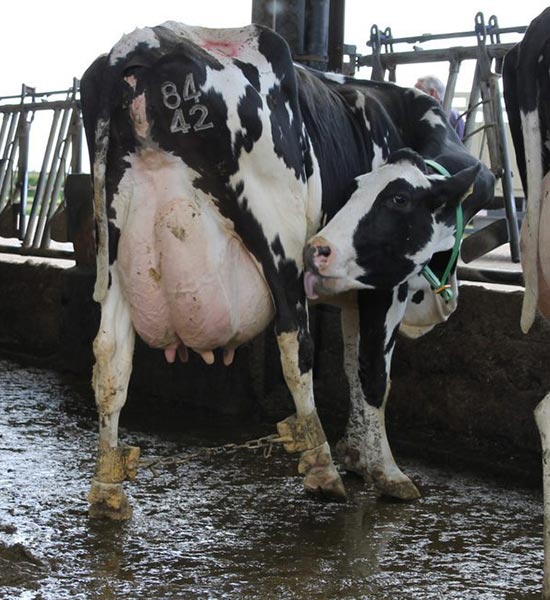 Breeding
Breeding
Young heifers are usually made pregnant at just 13 to 20 months of age, they then give birth when they are around two years old. After this, they will be expected to give birth again every year until their productivity falls and they are slaughtered.9Royal Society for the Prevention of Cruelty to Animals (RSPCA). Dairy cows – farming. Available at https://www.rspca.org.uk/adviceandwelfare/farm/dairy/farming [Accessed 9 October 2023].
Until recently, farmers typically purchased semen from older bulls whose merit was assessed based on the performance of their female offspring in the milking herd.10Wall E, Coffey M, Pritchard T et al. 2021. Incorporating novel data-driven approaches into cattle genetic improvement programmes leads to better animal performance and overall economic gains. Available at https://pure.sruc.ac.uk/en/impacts/incorporating-novel-data-driven-approaches-into-cattle-genetic-im [Accessed 9 October 2023]. Picking an unsuitable bull can result in bigger, bulkier calves that lead to birthing difficulties. Calving difficulties in heifers may be attributed to poorly grown (too small) heifers or oversized calves born from an inappropriately selected bull. The consequences can be horrific. Permanent nerve damage is one of the most severe outcomes of difficult calving and this affects a mother’s ability to control her back legs, resulting in her being unable to stand and doing the splits. The farmers’ answer is to shackle her hind legs together with steel ‘hobbles’.11Newkey-Burden C. 2018. Supporting the dairy industry inflicts more pain on cows than you know. And yes, that includes drinking their milk. The Independent, 25 September. Available at https://www.independent.co.uk/voices/dairy-industry-animal-rights-cow-treatment-milk-production-a8554196.html [Accessed 26 March 2020]. Although it is disturbing to see and hear an animal dragging around chains, it is standard practice in the industry as a means of keeping cows mobile and capable of walking to the milking parlour in order to exploit every last drop of milk she can produce.
In recent years, farmers have begun relying on genetic information to guide their semen-buying decisions. This means that farmers can evaluate ‘genetic merit’ at a younger age and in 2020, semen taken from young bulls accounted for 70 per cent of all inseminations compared to 25 per cent in 2013.10Wall E, Coffey M, Pritchard T et al. 2021. Incorporating novel data-driven approaches into cattle genetic improvement programmes leads to better animal performance and overall economic gains. Available at https://pure.sruc.ac.uk/en/impacts/incorporating-novel-data-driven-approaches-into-cattle-genetic-im [Accessed 9 October 2023]. So popular is the new way of selecting semen that 95 per cent of breeding companies promoting bulls to UK dairy farmers sign up to the Agriculture and Horticulture Development Board’s (AHDB) Dairy Semen Code of Advertising, which provides farmers with up-to-date comparable data on the genetic merit of the marketed semen, ensuring that “genomic information is built into farmers’ semen-buying decisions”.12AHDB. 2023. Dairy semen code of advertising. Available at https://ahdb.org.uk/dairy-semen-code-of-advertising [Accessed 9 October 2023].
The idea is not primarily to prevent calving difficulties, which still continue, as Viva! investigations have revealed, but to maximise profit. According to industry data, genetic evaluations have increased dairy cow productivity such that in 2019, cows were producing milk for an average of four to six months longer than in 2013, as they were less likely to be culled for non-production reasons such as poor health or fertility.10Wall E, Coffey M, Pritchard T et al. 2021. Incorporating novel data-driven approaches into cattle genetic improvement programmes leads to better animal performance and overall economic gains. Available at https://pure.sruc.ac.uk/en/impacts/incorporating-novel-data-driven-approaches-into-cattle-genetic-im [Accessed 9 October 2023].
Artificial Insemination
Between 90 and 95 per cent of dairy cows in the UK are impregnated by artificial insemination.10Wall E, Coffey M, Pritchard T et al. 2021. Incorporating novel data-driven approaches into cattle genetic improvement programmes leads to better animal performance and overall economic gains. Available at https://pure.sruc.ac.uk/en/impacts/incorporating-novel-data-driven-approaches-into-cattle-genetic-im [Accessed 9 October 2023]. The process is painful and traumatic for cows, who are forced into confined spaces to be impregnated. The farmer inserts one arm into the cow’s anus to manipulate her reproductive organs while an artificial insemination gun is inserted into her vagina to deposit semen. This highly unnatural way of impregnation causes cows distress, particularly as any mishandling of her organs can lead to severe pain and nerve damage. Inexperienced farmers practise on live animals and this inevitably leads to injuries.
Every dairy cow endures the same gruesome cycle of enforced insemination, pregnancy, giving birth, having her calf taken and then being impregnated again while being milked. This is repeated on average three to four times over the short course of a dairy cow’s life.
Calves

Following a nine-month pregnancy, the vast majority of calves are separated from their mother only hours or a few days after birth.13Levitt T. 2018. Dairy’s dirty secret: it’s still cheaper to kill male calves than to rear them. The Guardian, 26 March. Available at https://www.theguardian.com/environment/2018/mar/26/dairy-dirty-secret-its-still-cheaper-to-kill-male-calves-than-to-rear-them [Accessed 27 March 2020]. The industry argues that this is for the health of the calf. They claim it better enables them to measure the amount of colostrum – a form of milk that precedes the main milk supply and which contains antibodies to protect newborns against disease. In reality, calves are removed so all the cow’s milk can be taken for human consumption.
The separation process is a painfully emotional experience, with mother cows bellowing for days, calling for their lost babies. Female calves are replacements for the milking herd and are moved to isolated plastic hutches – much like an outdoor dog kennel – sometimes just metres away from their mothers. Here they can be confined legally for up to eight weeks before being transferred to group housing with other young females awaiting a life sentence of suffering.14National Animal Disease Information Service (NADIS). Calf housing. NADIS. Available at https://nadis.org.uk/disease-a-z/cattle/calf-management/calf-housing [Accessed 26 March 2020].
It is not uncommon to find calves older than eight weeks still living in isolation, struggling to fit inside their hutches, which were designed for much smaller animals. On a farm in South Devon, footage obtained by Viva! Campaigns showed calves of more than 12 weeks old still living in solitary hutches with little room to turn around, let alone exercise.15Poulter S. 2018. Distressing footage taken from inside British dairy farms shows calves torn from their mothers and crammed into tiny cages as one cow is left with a bone poking through its skin’. The Daily Mail. 30 April. Available at https://www.dailymail.co.uk/news/article-5672113/Disturbing-dairy-farm-footage-shows-apparently-emaciated-calves.html [Accessed 26 March 2020]. They were without food, water and maternal nurturing.
Female calves will eventually enter the dairy herd to replace worn out cows and will be forcibly impregnated for the first time during their second year of life.
The Fate of Male Dairy Calves
Pure-dairy-bred male calves are of little use to dairy farmers as they are unable to produce milk. It used to be common practice for farmers to shoot them at birth. A young calf at the centre of a 2011 Viva! Campaigns investigation into dairy farms supplying Cadbury, for example, was shot in the head on the back of a truck and his body was given to the local foxhounds for food.16Viva!, 2011. A calf and a half. Available at https://viva.org.uk/animals/campaigns/scary-dairy/investigation-cadbury/
In 2018, a Guardian investigation estimated that 95,000 male calves were being killed every year within a few days of birth.13Levitt T. 2018. Dairy’s dirty secret: it’s still cheaper to kill male calves than to rear them. The Guardian, 26 March. Available at https://www.theguardian.com/environment/2018/mar/26/dairy-dirty-secret-its-still-cheaper-to-kill-male-calves-than-to-rear-them. Following this bad publicity, supermarkets and dairy processors called for a ban on the routine killing of male calves and various industry-backed strategies were launched with the aim that dairy-bred calves should be reared for a purpose – as part of either the dairy or beef supply chains. In 2021, Red Tractor stated that the routine euthanasia of calves on-farm would end by 2023.17Red Tractor. 2021. Dairy standards. Available at https://redtractorassurance.org.uk/wp-content/uploads/2021/08/RTStandardsV5_Dairy_SINGLES.pdf [Accessed 10 October 2023].
Since then, two strategies have been employed to reduce the number of pure-dairy bred male calves: sexed semen is used to produce female dairy ‘replacers’ and beef semen is used to produce higher value calves to be sold on for beef or veal.
However, despite what the dairy industry claims about the use of new technologies reducing the death count, the dairy industry still kills tens of thousands (see numbers below) of young male calves every year.

Dairy Cow Life Cycle
Dairy farmers usually plan for their cows to give birth to their first calf when they’re around two, so heifers will usually be pregnant for the first time when they’re around 15 months old. They will be pregnant for nine months and produce milk for about 10 months after calving. After this, they will be expected to give birth again every year. The average UK dairy cow produces around 8,000 litres of milk each year and has just under four ‘milk producing cycles’ during her lifetime.9Royal Society for the Prevention of Cruelty to Animals (RSPCA). Dairy cows – farming. Available at https://www.rspca.org.uk/adviceandwelfare/farm/dairy/farming [Accessed 9 October 2023].
In nature, young herding mammals usually have regular physical and social contact with their mothers and the herd. In dairy production, early separation and social deprivation have been shown to have short-term (in calves) and long-term (in heifers or cows) effects on behaviour, stress reactivity and the ability to cope with different challenges.18Wagner K, Seitner D, Barth K et al. 2015. Effects of mother versus artificial rearing during the first 12 weeks of life on challenge responses of dairy cows. Applied Animal Behaviour Science. 164, 1-11.
Because of the extreme stress dairy farming methods put on their bodies, combined with unnaturally high milk yields, dairy cows are considered ‘spent’ typically by the age of around six and a half years.9Royal Society for the Prevention of Cruelty to Animals (RSPCA). Dairy cows – farming. Available at https://www.rspca.org.uk/adviceandwelfare/farm/dairy/farming [Accessed 9 October 2023]. Cows have a natural life expectancy of about 20 years but once their milk yield declines and they cease to be profitable, they are sent to slaughter to be sold as cheap beef.
Milk Yield
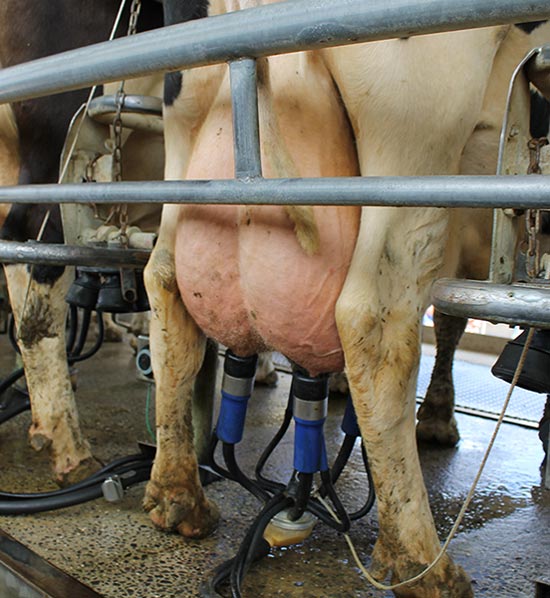
The most common breeds of dairy cattle in the UK are of the Holstein/Friesian variety, easily recognisable by their distinctive black and white colour patterning, and sometimes dark reddish brown and white. Their ability to produce extraordinarily high milk yields is what makes them the perfect ‘commodity’ to exploit. According to Defra, the average UK dairy cow produces around 27 litres every day.20AHDB. UK milk yield. Available at https://ahdb.org.uk/dairy/uk-milk-yield [Accessed 18 October 2023].
Through breeding techniques, the average amount of milk a dairy cow produces has increased dramatically over time. For example, in 1920, a North American Holstein cow produced on average 2,000 litres of milk a year. A century later, they produce over 10,000 litres of milk – five times more!21Medeiros I, Fernandez-Novo A, Astiz S et al. 2022. Historical evolution of cattle management and herd health of dairy farms in OECD countries. Veterinary Science. 9 (3) 125.
In the UK, the average amount of milk produced by a dairy cow has increased from 6,763 litres in 2004 to 8,169 litres (27 litres per day) in 2022.20Agricultural and Horticultural Development Board. 2023 (AHDBd). UK milk yield. Available at https://ahdb.org.uk/dairy/uk-milk-yield [Accessed 19 October 2023]. That’s an increase of over 20 per cent in less than 20 years.
The huge increase in milk yield over the years is due to selective breeding and intensification of herd management. It has inflicted a huge strain on cows, leading to complete body breakdown. The problem is made worse by the almost universal practice of impregnating cows a couple of months after they have started milking so that for seven months of every year they face the dual burden of producing vast quantities of milk and nurturing a growing foetus. It is an impossible burden!
A calf would normally feed five to six times a day and the maximum amount of milk in the cow’s udder at any one time to meet this demand would be around two litres. But on most dairy farms, a cow is milked only twice a day, meaning that up to 20 litres of milk can accumulate in her udder. This greatly enlarges it, causes pain, leads to lameness in her hind legs and predisposes her to mastitis (a painful infection of the udder).
An increasing number of farms use an automatic milking system (AMS) to increase milk production and decrease labour costs – thus increasing profit. With automated systems, cows may be milked two or three times a day. However, research suggests an increase in milk production of two to 12 per cent in cows milked more than twice a day in AMS compared with cows milked twice per day in traditional milking parlours.22Cogato A, Brščić M, Guo H et al. 2021. Challenges and tendencies of automatic milking systems (AMS): A 20-years systematic review of literature and patents. Animals (Basel). 11 (2) 356. So, despite robotic milkers being heralded as benefitting welfare, they may do little to relieve the burden of oversized udders.
Housing and Intensification
Some dairy cows in the UK graze outside during the day for six months of the year (April to September) but are confined to sheds for the remaining six months, with no access to the outdoors. If the weather is bad, they can be incarcerated for even longer. These sheds rarely provide cows with the space they need and prevent them from expressing their natural instincts for at least half their lifetime.
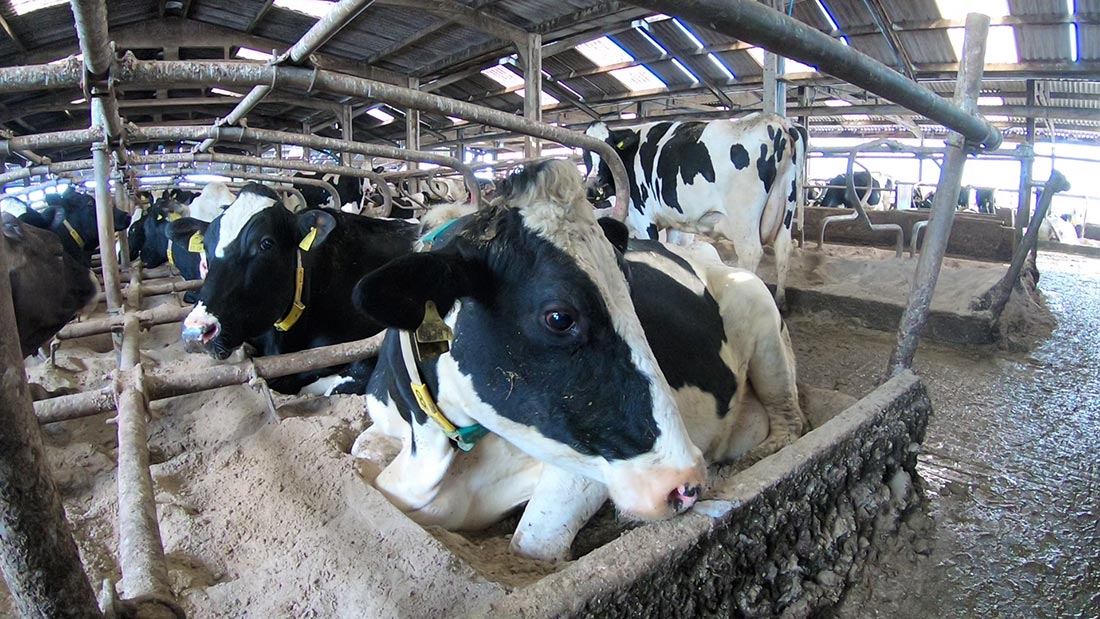
Zero Grazing
An increasing number of dairy cows in the UK are being farmed under a system referred to as zero grazing. They literally never graze outside but are instead fed on a diet of silage (wet, fermented grass) and a high-concentrate mixture of cereals, rape meal, sunflower meal, maize and soya. They may be kept permanently in sheds or yards but never walk on grass.
This method clearly deprives the cow of her natural environment and increases the risk of lameness, hoof problems, teat tramp, mastitis, metritis, dystocia, ketosis, retained placenta and some bacterial infections.23EFSA Panel on Animal Health and Animal Welfare (AHAW). 2009. Scientific opinion of the panel on animal health and welfare on a request from European Commission on welfare of dairy cows. The EFSA Journal. 1143, 1-38.24Arnott G, Ferris CP and O’Connell NE. 2017. Review: welfare of dairy cows in continuously housed and pasture-based production systems. Animal. 11 (2) 261-273.
It’s estimated that 20 per cent of dairy farms now use zero grazing systems and it is likely that the trend will increase as profit is placed before wellbeing.25Compassion in World Farming. 2016. The grass is greener – the plight of dairy cows. Available at: https://www.ciwf.org.uk/news/2016/04/the-grass-is-greener-the-plight-of-uk-dairy-cows-f1 Accessed 19 October 2023.
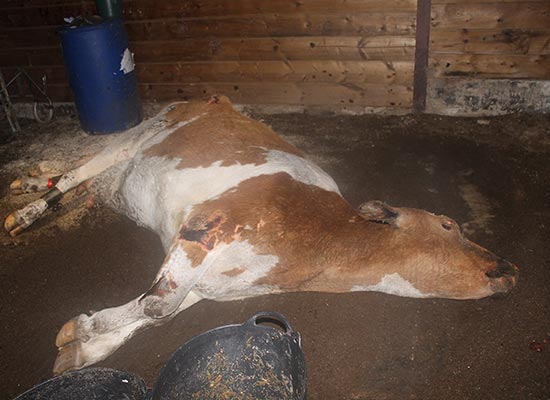 Disease and Illness
Disease and Illness
The dairy cow is arguably the hardest worked of all farmed animals, forced into a perpetual cycle of dual pregnancy and lactation, confined to live more than half the year in barren sheds and fed unnatural mixtures of silage. It has produced a situation where she simply cannot consume enough food to keep pace with what is demanded of her – nurturing an unborn calf while still lactating from a previous pregnancy. Whatever the system, the result is the same – ‘metabolic starvation’. Cows have to draw on their body reserves to meet these unnatural demands, resulting in a ‘coat rack’ appearance where her bones and spine protrude through her skin. It is extremely common and a sure indication of malnourishment.
Mastitis is when there is an infection that causes inflammation of a cow’s udder. It is the most frequent and costly illness impacting dairy herds worldwide. In the UK, the average number of cases ranges from around 50 to 70 cases per 100 cows per year. Some individual farm levels may be even higher.26National Animal Disease Information Service. 2015. Part 5 : The impact of mastitis and lameness on fertility. Available at https://www.nadis.org.uk/disease-a-z/cattle/fertility-in-dairy-herds-advanced/part-5-the-impact-of-mastitis-and-lameness-on-fertility[Accessed 23 October 2023]. It is caused by bacteria entering through the teat and releasing toxins, which leads to damage of the milk-producing tissue and canals throughout the udder. The body fights the infection by releasing white blood cells and when they destroy the bacteria, the resulting pus (white blood cells combined with bacterial remains) is excreted through the teat. Mastitis can be treated with antibiotics but milk from cows undergoing antibiotic treatment is not usable. However, cows with mastitis that either hasn’t been diagnosed or hasn’t become life-threatening, are often milked anyway, with farmers hoping that their milk will meet the rather generous allowance for somatic cells (pus) in milk of up to 400 million per millilitre (EU regulation). That’s two million in one teaspoonful!
The widespread nature of mastitis in British farming is directly due to the ruthless demand for high output, whether within intensive, free range or organic systems.
Lameness, due to injury or disease in the foot or leg, is also one of the most important welfare problems facing dairy cows. Lame dairy cows may experience: pain and discomfort; disturbed resting, feeding and social patterns; reduced fertility; lower milk yields; and an increased likelihood of being culled.27Universities Federation for Animal Welfare. 2023. Lameness in dairy cattle. Available at https://www.ufaw.org.uk/why-ufaws-work-is-important/lameness[Accessed 23 October 2023].Around one-quarter of all dairy cows may be experiencing some degree of lameness at any one time.27AHDB. 2023. Lameness in dairy cattle. Available at https://ahdb.org.uk/knowledge-library/lameness-in-dairy-cows[Accessed 23 October 2023]. However, virtually all cows’ hooves show past or present damage when they are inspected at slaughter.27Universities Federation for Animal Welfare. 2023. Lameness in dairy cattle. Available at https://www.ufaw.org.uk/why-ufaws-work-is-important/lameness[Accessed 23 October 2023]. The general causes of lameness are poor quality floors, poor cow tracks, forcing cows to stand for too long on hard surfaces, poorly-designed cubicles, ineffective foot trimming, infectious diseases and malnutrition – all of which stem from poor management and mistreatment of cattle by farmers.28AHDB. 2023. Lameness in dairy cattle. Available at https://ahdb.org.uk/knowledge-library/lameness-in-dairy-cows[Accessed 23 October 2023].
The list of potential diseases affecting dairy cows is almost endless, with some diseases more significant than others.29AHDB. 2023. Diseases affecting dairy cows. Available at https://ahdb.org.uk/diseases-affecting-dairy-cows[Accessed 23 October 2023]. There are a number of complex factors leading to disease in dairy cows but generally they occur because of the excessive demands farmers place on their herds to produce high milk yields. Abnormally large udders push the cow’s hind legs apart and force her to adopt an irregular gait, putting extra pressure on the outer claws of her hooves; nutritionally deficient feed concentrates absorbed by the bloodstream irritate the soft tissues in her soles; and the accumulation of bacteria-ridden, highly acidic slurry in sheds and on which the cows are forced to stand, are breeding grounds for infection.
Culling
The most common reasons for which a dairy cow is culled include infertility, mastitis, lameness and poor milk production, which are clear indicators of poor welfare standards. Farmers usually cull cows as soon as they become unprofitable. In the words of the AHDB: “One way of decreasing milk production is to cull less profitable, or ‘passenger’ cows.”30AHDB. 2020. What could an increase in dairy cow culling mean for the markets? Available at https://ahdb.org.uk/news/what-could-an-increase-in-dairy-cow-culling-mean-for-the-markets[Accessed 23 October 2022].

Calves
81,744 male dairy calves under eight months old were killed in 2024. Of those, 49,204 under the age of eight months were killed in slaughterhouses, a slightly lower number than in previous years (57,435 in 2023 and 59,658 in 2022).1Rural Payments Agency. 2025. FOI release RFI 7326 number of male calves killed in slaughterhouses and on-farm.
Also included in the 81,774, were 32,540 male calves under the age of two months who were killed on-farm in 2024, a similar number to previous years (33,727 in 2023 and 33,451 in 2022).1Rural Payments Agency. 2025. FOI release RFI 7326 number of male calves killed in slaughterhouses and on-farm.
In slaughterhouses: 94 per cent of calves less than eight months old were stunned prior to slaughter (85 per cent by captive bolt, six per cent by electronarcosis and the rest by halal stun methods). Six per cent were slaughtered by non-stun methods, mainly halal non stun (see the Religious Slaughter section of How Animals are Killed).2Food Standards Agency. 2024. Results of the 2024 FSA Slaughter Sector Survey in England and Wales. Available at: https://www.gov.uk/government/publications/farm-animals-slaughter-sector-survey-2024 After being stunned, the calves were ‘bled out’ (knifed in the neck to sever major blood vessels and bled to death).
On farm: legal methods to kill the unwanted male dairy calves on farm include a shot to the head with a free bullet from a shotgun, pistol or rifle; or a penetrative captive bolt device, followed by pithing or bleeding. (It is unknown what percentage of each are used.) Male calves killed on farm don’t enter the human food chain, but may be sent to a knackers yard, processed for pet food or fed to hunting dogs, burnt (incineration), buried or sent for rendering to be used in a wide range of products. By law, people who kill animals on farm must have either a Welfare of Animals at the Time of Killing (WATOK) licence or a Certificate of Competence (CoC).
Dairy cows
After suffering their whole lives, worn out dairy cows often endure gruelling journeys to market, where they are likely to be bought and sent to fattening (finishing) farms before being slaughtered and ending up in low-quality beef products, such as pies, burgers, soups and baby food. After only a fraction of their natural 20-year life expectancy – mostly being slaughtered, when exhausted, at around six and a half years old.3Royal Society for the Prevention of Cruelty to Animals (RSPCA). 2025. Dairy cows – farming. Available at https://www.rspca.org.uk/adviceandwelfare/farm/dairy/farming
Most cattle in the UK are stunned with a captive-bolt pistol.4Humane Slaughter Association. 2025. Frequently asked questions. Available at https://www.hsa.org.uk/faqs/slaughter. A penetrative captive bolt (it remains attached to the gun) is shot into the forehead of a cow, its percussive impact intended to render the cow immediately unconscious. She is then shackled by a hind leg and hoisted up when the slaughter worker will ‘stick’ her and sever both veins and arteries. The cow is then bled to death.5Royal Society for the Prevention of Cruelty to Animals (RSPCA). 2025. Animal slaughter fact file. Available at https://www.rspca.org.uk/adviceandwelfare/farm/slaughter/factfile
Although it is argued that the death is painless because the cow is stunned, the moments leading up to stunning and slaughter are often terrifying for the animal; she can hear the anxious bellows and smell the fear of other cows in the slaughterhouse and often cows will do their utmost to escape. Transportation, slaughterhouse and stunning are all barbaric and traumatic.
The stunning process does not guarantee that the cow will lose consciousness before being killed and there may be frequent failures. A cow’s skull is hard to penetrate, the shot may fail and there is also the risk of human error. The cow may suddenly move and the shot hit the wrong place, even her cheek or face, and the process has to be repeated. Cows may also regain consciousness while they are hanging up and have their throats slit while conscious. The suffering must be immense.
Some members of certain religious groups demand that any animal they eat must be conscious when their throat is cut. The latest Food Standards Agency figures show an estimate of 30 million animals were slaughtered without pre-stunning in 2024.6Royal Society for the Prevention of Cruelty to Animals (RSPCA). 2025. End non-stun slaughter for farm animals. Available at https://www.rspca.org.uk/getinvolved/campaign/slaughter Some ritually slaughtered meat finds its way onto mainstream markets without any labelling so many British consumers are unknowingly eating animal products that have come from non-stunned animals.7Dalton J. 2019. Shoppers unknowingly buying no-stun religious meat in supermarkets. The Independent, 19 February. Available at https://www.independent.co.uk/news/uk/home-news/meat-animals-no-stun-halal-meat-supermarkets-religion-kosher-food-ban-standards-agency-a8786541.html
Door-Dropper Leaflets
Spread awareness about the plight of dairy cows by becoming a ‘door-dropper’ for Viva!. One of the biggest problems we face in getting our message to people is that a lot of the information they need to know just doesn’t reach them. Door-dropping is the easiest form of outreach!
Door-dropping means distributing leaflets by putting them through people’s letterboxes. It’s a gentle but effective form of outreach and it’s also time-efficient – you can cover a street in just a few minutes.


Why You Don’t Need Dairy Guide
The must-have guide for anyone who is, or wants to be, dairy-free. All you need to know about dairy – and why you’re better off without it.
The Dark Side Of Dairy Report
Everything you need to know about the dairy industry, life of dairy cattle and other issues such as goat farming.
Dairy Takes Babies Away
Suggested caption: Mothers and their female offspring naturally stay in the same herd for life. The dairy industry takes babies away a few hours after birth just so humans can have her milk. This is traumatic for both the mother and the baby, who will never see each other again. Choose vegan.
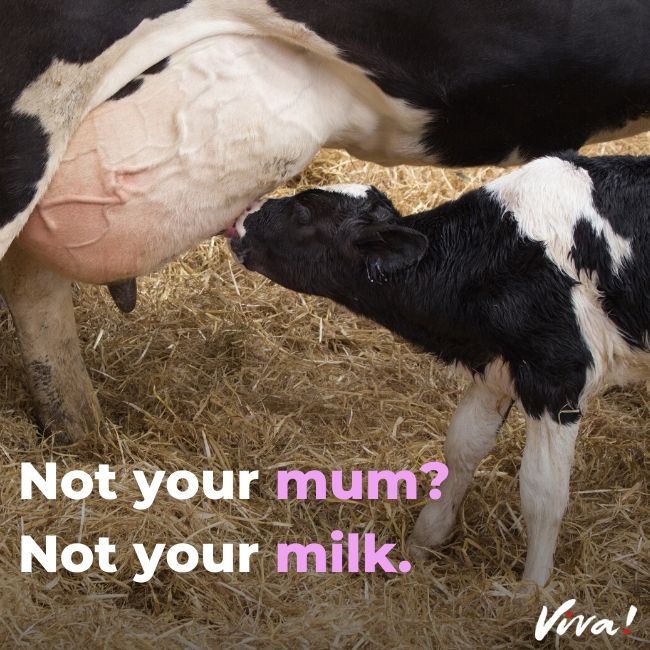
Not your mum? Not your milk.
Suggested caption: Like us, cows only produce milk when they have a child to feed. Mothers have their baby stolen within hours of giving birth, all so humans can drink her milk made for her baby. Not your mum? Not your milk! Choose vegan.
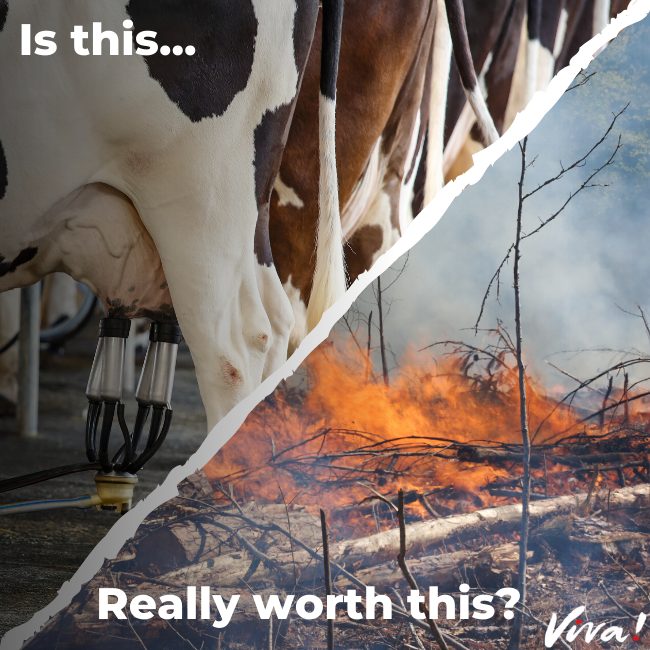
Is Dairy Really Worth It?
Suggested caption: Dairy is the biggest greenhouse gas emitter in the EU food system and a leading cause of global warming. Next time you buy dairy, ask yourself: is it really worth it?
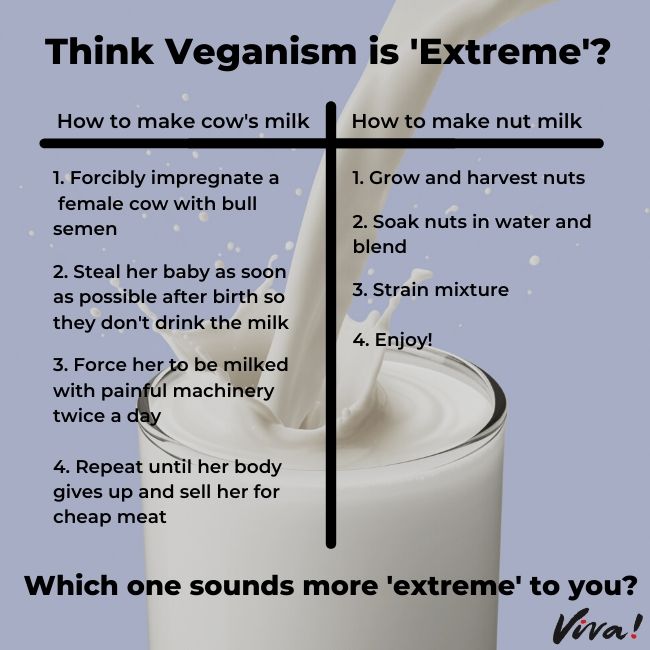
Think Veganism Is Extreme?
Suggested caption: Which one sounds more extreme to you?
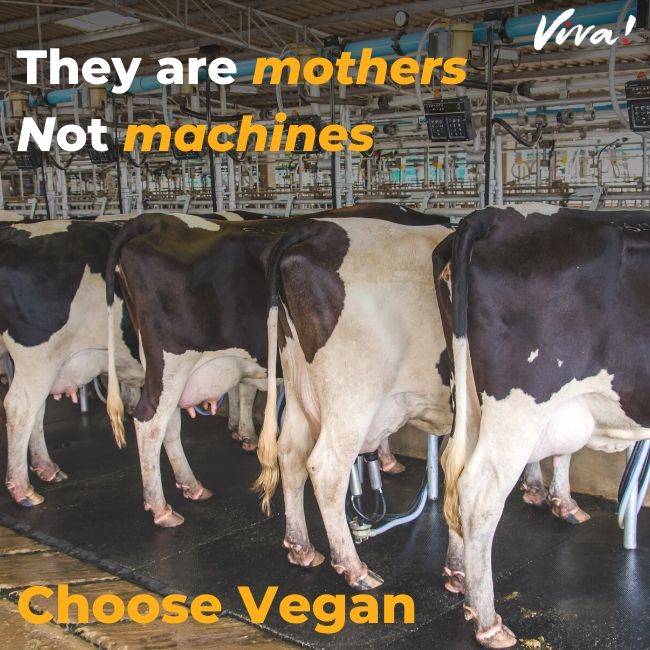
They Are Mothers, Not Machines
Suggested caption: Cows are socially complex animals who form bonds for life. Mothers stay with their female offspring for life in the wild, but the dairy industry takes this away. Mothers are treated like milk machines, routinely impregnated and separated from their babies just so humans can have her milk. Choose vegan!




